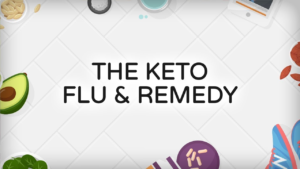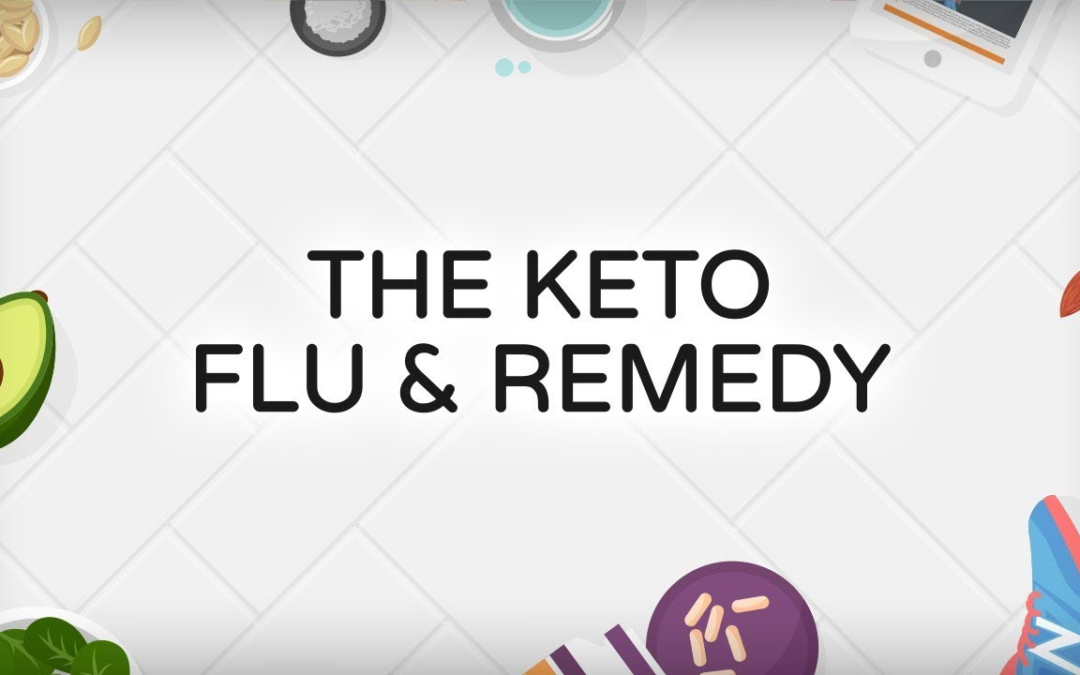You started ketogenic nutrition a few days ago and somehow it doesn’t work out with the change in diet.
Instead of all the benefits of ketosis you have heard of – better fat burning, more energy, better concentration – you sit tired and a little confused at the breakfast table.
Who is to blame for this situation? Ah yes … the keto flu! A perfectly normal response from your body to the switch from sugar to fatty acids as the primary source of energy. Because to completely change your metabolism must first make some important modifications.
Now you’re sure to ask yourself: How long does a keto flu last? What are the symptoms? How can I get these symptoms under control? And why am I feeling so tired?
We’ll answer all of these questions and more in the course of this article. Learn everything you need to know about keto flu to get through this section of ketosis as quickly as possible.
One of the side effects of the keto diet is the keto flu. This appears at the beginning of this type of diet due to the period of adaptation that our body performs. It is not a flu itself, it is not contagious, but it is given this name due to the symptoms it presents, similar to those of a common flu. The keto flu usually appears in the first phase, when we start this diet, and usually lasts between 2 and 5 days. Not everyone suffers from it and much less all the symptoms occur at the same time. The magnitude in which it is experienced, depends above all on the eating habits that were previously followed. Fortunately, it is temporary and you will soon feel good. And what is better, there is a simple solutions that usually resolves most or all symptoms. Keep reading to find out what it is!
WHAT IS THE KETO FLU?
The keto flu describes the symptoms of a change in diet. The keto flu consists of several symptoms that people feel when they start ketogenic diet for the first time. Keto flu is also one of the first signs of ketosis.

These symptoms are very similar to those of flu and they arise because the body first has to adapt to the diet with a very low amount of carbohydrates. By reducing carbohydrates, you are forcing your body to use fatty acids and ketone bodies instead of sugar and carbohydrates for energy. Ketones (ketone bodies) are a by-product when fats are used by your body as a primary source of energy.
Typically, fat is used as a secondary source of energy to bridge times when your body doesn’t have access to enough carbohydrates and glucose.
The conscious switch to the use of fats as the primary energy source is known as ketosis. Your body gets into ketosis when you are fasting, hungry or if you consciously forego the majority of carbohydrates and thereby reduce your daily consumption to less than 50 grams.
Your body reacts to the reduction of carbohydrates in your diet with withdrawal symptoms. After all, he has had carbohydrates every day for the past few years. He has now got used to it.
The good news is: The condition of the keto flu is only temporary! So that we can take a closer look at what you can do about keto flu, you should first understand why your body reacts with such unpleasant symptoms in the first place.
CAUSES OF THE KETO FLU
The symptoms of keto flu are related to how the body shifts concerning how it can gain energy from your food and the nutrients it contains.
Normally, carbohydrates gives energy to your body in the form of glucose. However, when it stops getting carbohydrates, it burns ketones and fatty acids instead of glucose to gain energy.
This process can take a few days and especially people who have consumed many simple carbohydrates in the form of pasta, sugary cereal flakes or soft drinks like Coca-Cola or Fanta will experience more intense symptoms before changing their diet.
This is sometimes the reason why some people do not get keto flu at all. These people usually consumed carbohydrates and sugar in manageable amounts even before the changeover.
There are also indications that genetics, electrolyte balance and dehydration can influence the strength and expression of the following symptoms.
SYMPTOMS OF THE KETO FLU
As soon as you change your eating habits and eat few or no carbohydrates as part of the ketogenic diet, your body needs some time to adapt to it.
For some people, this time of transition can be worse than for others. You will observe relatively quickly which group you will belong to.
The first symptoms of keto flu usually appear three to five days after the change in diet. The extremity of the symptoms varies from person to person.
While some people can easily transition to ketogenic diet, most people experience one or more of the following symptoms of keto flu:
- fatigue
- dizziness
- stomach pain
- muscle fatigue
- sleep problems
- a headache
- Slight nausea
- Sugar cravings
- Reduced ability to concentrate
These symptoms are primarily felt when you have just started ketogenic nutrition. The symptoms usually last a maximum of one week. Although, this duration can differ from person to person.
To be on the safe side that you can attribute these symptoms to ketosis and not normal flu, it makes sense to measure your ketone levels with appropriate equipment to make sure you are already in ketosis.
Many beginners who start on the ketogenic diet are discouraged by these initial symptoms. However, there are several ways to relieve these symptoms and speed up the onset of ketosis.
Beginners who have just started on the ketogenic diet will experience symptoms such as tiredness, lack of concentration, headache and mild nausea in most cases.
WHAT TO DO AGAINST THE SYMPTOMS
You can do that against the symptoms of keto flu
If you have the keto flu, you feel miserable. Fortunately, there are several effective and tried-and-tested ways to get the symptoms of keto flu under control.
-Eat enough fats
In the course of the switch to the ketogenic diet, you will notice that in the meantime you will have incredibly strong cravings for cookies, bread or pasta.
You can get these desires under control by simply eating more fats. This is because your body is now using fat as an alternative energy source to carbohydrates. He just doesn’t know yet and continues to signal that he wants carbohydrates.

So you have to outsmart him and steer your carbohydrate cravings toward high quality fats. Even science shows that this trick works in practice and an increased consumption of high-quality fats (e.g. MCT oil) also reduces cravings for sugar.
What you can also try to reduce the intensity of the symptoms of keto flu is to slowly reduce the amount of carbohydrates and not overnight. For example, in the first step you can start cutting carbohydrates from your breakfast. Bulletproof Coffee, for example, is a good alternative to a high-carb breakfast.
At the same time, you should slowly increase the amount of proteins and fats in your keto diet. This gives your body more time to make the switch.
-Drink plenty of water
Drinking plenty of water is essential for your health and performance anyway.
Since a ketogenic diet can cause your body to drain heavily at the beginning of the changeover, this also increases the risk of you becoming dehydrated.
This is because glycogen, the stored form of carbohydrates, binds to water molecules. Reducing the amount of carbohydrates in your diet also reduces the amount of glycogen in your body. The water bound to it is also excreted with the glycogen.
Therefore, drinking too much can counter symptoms such as muscle weakness, headache, or fatigue.
-Avoid intensive workouts
While intensive training can help you improve your health and get ketosis faster, it can also cause the intensity and severity of symptoms of keto flu to get worse.
Fatigue, mild muscle cramps and minimal abdominal pain are common symptoms that you will experience in the first week after changing your diet. It makes sense to give your body a little break during this time.
Therefore, you should avoid strenuous workouts and instead concentrate on less intensive activities such as light cycling, walking or yoga.
-Get enough sleep
Fatigue, mild confusion, and dizziness are symptoms you’ll experience during a classic keto flu.
Lack of sleep and sleep problems also cause your body to release the stress hormone cortisol. This can harm the strength of the symptoms as well as your mood and your emotional world.
Therefore, make sure that you sleep sufficiently, especially in the course of the first four weeks after changing your diet, and work actively on your sleep quality.
If you have trouble falling asleep, you can try one or more of the following sleep hacks:
Consume less caffeine. Avoid caffeine completely after 2:00 p.m.
Take a relaxing bath with lavender oil
Get up early and go to bed early. This regulates your sleep rhythm
Turn off smartphones or notebooks 30 minutes before bed. Avoid blue and bright light before sleeping.
-Replace missing electrolytes
If you start eating ketogenic, your insulin level will inevitably drop a little. As your insulin levels drop, your kidneys will drain excess sodium from your body through your urine.
In addition to this effect, the ketogenic diet limits the consumption of foods that are high in potassium. These include fruits, beans and starchy vegetables.
However, it is magnificent important to maintain the level of these essential nutrients in your body. Especially in the phase of changing your diet, a lack of electrolytes and important nutrients can worsen the symptoms of keto flu.
By using more salt than usual and including green leafy vegetables and avocados in your diet, you can prevent deficiency, maintain a healthy electrolyte balance and reduce some symptoms of keto flu.
HOW LONG DOES A KETO FLU LAST?
The duration of the keto flu varies from person to person
Fortunately, a normal keto flu only lasts a few days. You will feel the symptoms for a maximum of an entire week.
The symptoms also appear relatively quickly and then become less severe from day to day. You can also help your body with the changeover with the above tips. This also reduces the duration of the keto flu, among other things.
WHAT HAPPENS AFTER I GET THE KETO FLU?
Once the keto flu is over, a huge increase in energy levels can be expected, and once the sugar habit has been eliminated, people often feel better than ever.
Being patient while your body adapts is key, and knowing what will happen, and if you don’t, you should seek the attention of a qualified medical professional.
SUMMARY
The symptoms of keto flu usually last from a few days to a week. However, there are ways to shorten the duration of the keto flu.
All things Considered
The keto flu describes several symptoms that occur as part of the change in diet towards a ketogenic diet. A keto flu usually lasts from a few days to a week.
Symptoms include headache, fatigue, mild concentration problems and cravings for sugar or carbohydrates.
By eating more fats, drinking lots of water, not doing intensive workouts and getting enough sleep, you can alleviate the symptoms of keto flu and reduce the duration.

